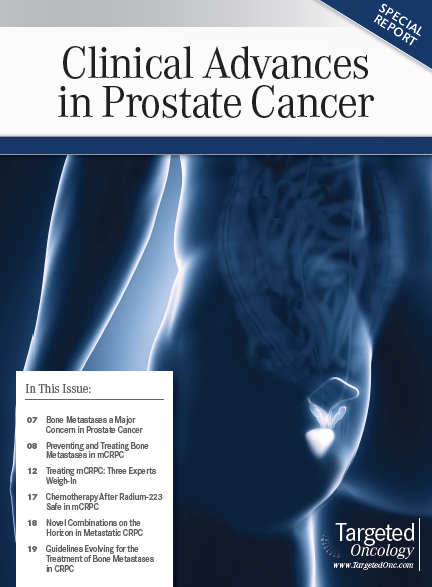Novel Combinations on the Horizon in Metastatic CRPC
Novel combination approaches are currently under exploration that hope to capitalize on the varying mechanisms of action for each newly approved agent for men with metastatic castration-resistant prostate cancer (mCRPC).
Novel combination approaches are currently under exploration that hope to capitalize on the varying mechanisms of action for each newly approved agent for men with metastatic castration-resistant prostate cancer (mCRPC), according to a panel discussion that was led by Raoul S. Concepcion, MD, from Urology Associates, PC, in Nashville, Tennessee.
Chief among the strategies discussed were those involving the alpha particle emitting radiopharmaceutical radium-223 (Xofigo) with the androgen receptor (AR)-targeted agents abiraterone acetate (Zytiga) or enzalutamide (Xtandi). At this time, data from a large prospective clinical trial assessing the combination of an AR-targeted therapy with radium-223 is not yet available. However, despite this lack evidence, many clinicians are commonly administering abiraterone or enzalutamide concurrently with radium-223, explained Daniel P. Petrylak, MD.
“I think people combine these agents. There’s no data to support that right now, but they do it off-label,” explained Petrylak, from the Yale Cancer Center, who encouraged participation in a clinical trial. “There’s a randomized phase II study looking at radiographic endpoints of enzalutamide plus radium versus abiraterone plus radium versus radium. And there’s also a larger randomized trial of abiraterone plus radium versus radium that’s going on as a registration study.”
In an analysis of patients treated in an expanded access program for radium-223 it was found that concurrent enzalutamide and abiraterone did not appear to impact outcomes with radium-223.1 In those who received radium-223 with concurrent enzalutamide (n = 15), the median overall survival (OS) was 10.7 months. In the concurrent abiraterone arm (n = 25), the median OS was not estimable at the time of the analysis.
“I think realistically a lot of people are using combinations, particularly when you get in a situation where the patient has more predominant lymphadenopathy over 3 cm or so, that’s very tempting to say, well, let’s add some abiraterone on there or enzalutamide,” said Celestia S. Higano, MD, from the Seattle Cancer Care Alliance, in the discussion. “I think realistically it has been shown in marketing research that a lot of people are automatically using combinations.”
Clinical trials are currently exploring combination strategies for patients with mCRPC, including a three-arm phase IIa investigation assessing each AR-therapy with radium-223 or radium-223 alone (NCT02034552). Additionally, a phase III study is looking at abiraterone plus radium-223 in men with bone-metastatic CRPC prior to the administration of chemotherapy (NCT02043678). A similar phase III study is expected to begin enrolling soon to test enzalutamide plus radium-223 (NCT02194842).
In addition to AR-agents, questions remain regarding radium-223 in combination with therapies intended to prevent or delay skeletal-related events, such as denosumab (Xgeva) or zoledronic acid (Zometa). However, the answer to this question could lie in a subgroup analysis from the pivotal ALSYMPCA trial, which led to the approval of radium-223, Higano said.
In this large phase III study,2 those who received zoledronic acid plus radium-223 (n = 250) experienced a median OS of 15.3 months compared with 11.5 months with placebo and zoledronic acid (HR, 0.70). In patients treated without zoledronic acid, those who received radium-223 (n = 364) had a median OS of 14.5 months versus 11.0 months with placebo (HR, 0.74).
In the full population of the study, treatment with radium-223 demonstrated a median OS of 14.9 months compared with 11.3 months with placebo for patients with bone-metastatic CRPC (HR, 0.70, P < 0.001). Additionally, radium-223 was associated with a significant delay in both the median time to first symptomatic skeletal-related events and the time to an increase in the PSA level.
“If you look in the ALSYMPCA trial, they did forest plots of patients who were and were not on zoledronic acid,” Higano explained. “There was an advantage to being on the combination, so that’s why I continue my bone drug and I realize denosumab was not in that trial, but they seem to be similar.”
Overall, less than half of the patients enrolled in the ALSYMPCA trial were receiving treatment with a bisphosphonate (n = 374; 41%). In addition to this study, the large PROCEED registry showed a similar rate of utilization for bone-targeted agents of around 40%, added Concepcion. The findings enhance the need for further education on the importance of bone health, he concluded.
References
- Shore ND, Vogelzang NJ, Fernandez D, et al. Radium-223 Dichloride in Expanded-Access Setting in the United States: Overall and Concurrent Experience With Abiraterone or Enzalutamide. Presented at: the: American Urological Association Annual Meeting; Tuesday, May 19, 2015; New Orleans, LA. Abstract: MP87-12.
- Parker C, Nilsson S, Heinrich D, et al. Alpha emitter radium-223 and survival in metastatic prostate cancer. N Engl J Med. 2013;369(3):213-223.
